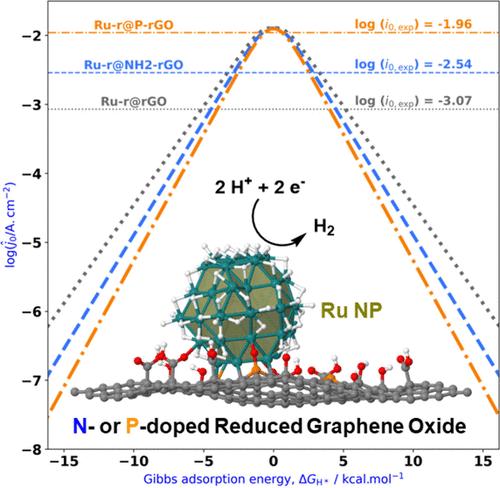氮磷掺杂还原性氧化石墨烯对负载型Ru纳米颗粒析氢催化活性的影响
IF 8.2
2区 材料科学
Q1 MATERIALS SCIENCE, MULTIDISCIPLINARY
引用次数: 0
摘要
研究了用于析氢反应(HER)的三种不同阴极材料,这些材料由钌纳米颗粒(NPs)支撑在裸露和两种掺杂的还原氧化石墨烯(r-GO)上。钌NPs通过有机金属方法在每个还原石墨烯载体(裸(rGO), n掺杂(NH2-rGO)和p掺杂(P-rGO))存在的情况下原位合成。(HR)TEM, EDX, EA, ICP-OES, XPS, Raman和NMR技术对得到的rgo负载Ru材料进行了全面表征。这些材料被沉积在玻璃碳旋转圆盘电极(GC-RDE)上,以评估它们在酸性ph下的HER电催化活性。结果表明,所有三种材料在还原条件下至少稳定12小时,石墨烯结构的杂原子掺杂极大地提高了电极的活性,特别是对于Ru@P-rGO,其- 10 mA·cm-2的过电位降至仅2 mV。对三种rGO载体的实际(基于实验成分数据)建模,结合对混合纳米催化剂的电子和电催化性能的DFT计算分析,可以将观察到的电催化性能归因于相关因素的组合,如Ru原子与掺入的rGO载体的距离和Ru NP表面的氢化物含量。本文章由计算机程序翻译,如有差异,请以英文原文为准。

Effect of Nitrogen and Phosphorus Doping of Reduced Graphene Oxide in the Hydrogen Evolution Catalytic Activity of Supported Ru Nanoparticles
Three different cathodic materials for the hydrogen evolution reaction (HER) consisting of Ru nanoparticles (NPs) supported onto a bare and two doped reduced graphene oxides (r-GO) have been studied. Ru NPs have been synthesized in situ by means of the organometallic approach in the presence of each reduced graphene support (bare (rGO), N-doped (NH2-rGO) and P-doped (P-rGO)). (HR)TEM, EDX, EA, ICP-OES, XPS, Raman and NMR techniques have been used to fully characterize the obtained rGO-supported Ru materials. These materials have been deposited onto a glassy carbon rotating disk electrode (GC-RDE) to assess their HER electrocatalytic activity at acidic pH. The results show that all three materials are stable under reductive conditions for at least 12 h, and that the heteroatom-doping of the graphene structure extremely increases the activity of the electrodes, especially for the case of Ru@P-rGO, where the overpotential at −10 mA·cm–2 decreases to only 2 mV. Realistic (based on experimental compositional data) modeling of the three rGO supports combined with DFT computational analysis of the electronic and electrocatalytic properties of the hybrid nanocatalysts allows attributing the observed electrocatalytic performances to a combination of interrelated factors such as the distance of the Ru atoms to the dopped rGO support and the hydride content at the Ru NP surface.
求助全文
通过发布文献求助,成功后即可免费获取论文全文。
去求助
来源期刊

ACS Applied Materials & Interfaces
工程技术-材料科学:综合
CiteScore
16.00
自引率
6.30%
发文量
4978
审稿时长
1.8 months
期刊介绍:
ACS Applied Materials & Interfaces is a leading interdisciplinary journal that brings together chemists, engineers, physicists, and biologists to explore the development and utilization of newly-discovered materials and interfacial processes for specific applications. Our journal has experienced remarkable growth since its establishment in 2009, both in terms of the number of articles published and the impact of the research showcased. We are proud to foster a truly global community, with the majority of published articles originating from outside the United States, reflecting the rapid growth of applied research worldwide.
 求助内容:
求助内容: 应助结果提醒方式:
应助结果提醒方式:


